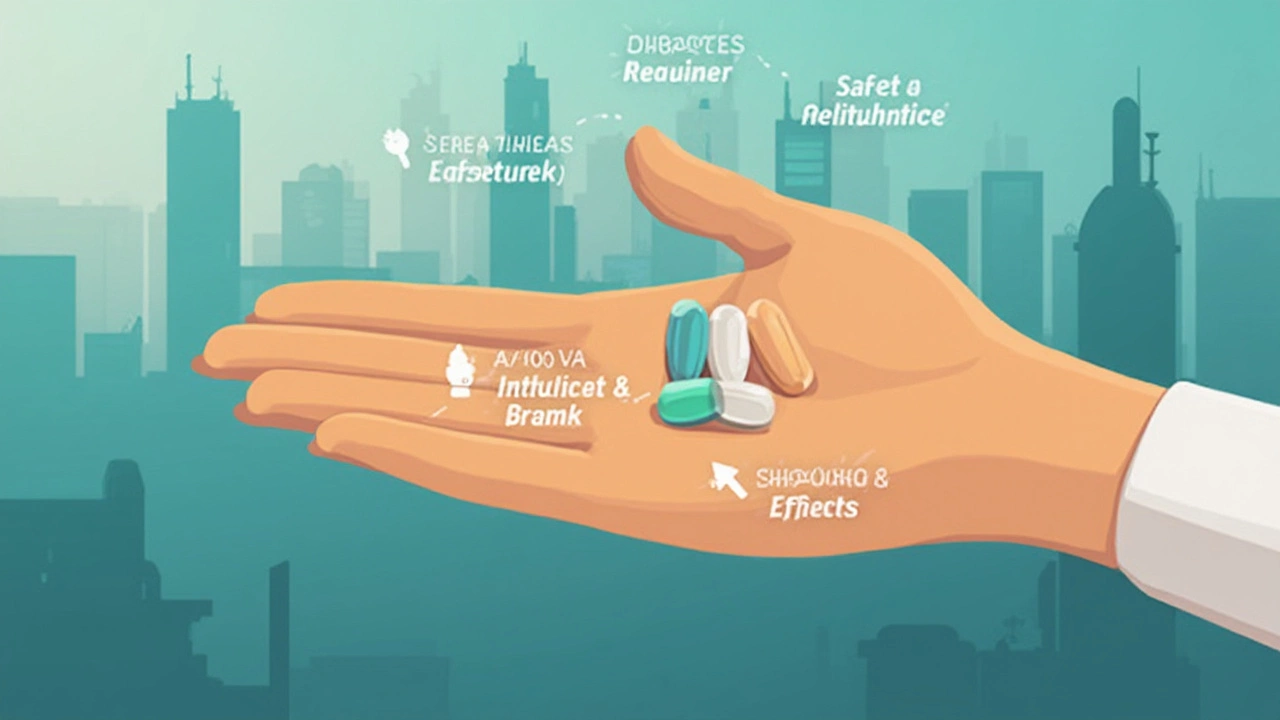Picking a diabetes medicine that’s actually safe can feel like walking through a maze, especially when everyone throws around fancy names and complicated terms. Here’s the thing: safety isn’t one-size-fits-all. The best option for your neighbor might raise your blood sugar or give you a nasty side effect. And let’s not even get started on what gets hyped up online.
It’s way more useful to look at how blood sugar meds work and which ones tend to behave themselves—meaning, they do their job without messing up the rest of your health. Ever heard of metformin? It’s been around for decades, and for most folks, it’s the starter medicine for type 2 diabetes. Doctors love it because it’s cheap, doesn’t usually mess with your weight, and the chances of dangerous lows are tiny.
But hold on. Not everyone can take metformin, like if you’ve got some kidney trouble. And if you’re shopping for something newer, you’ll see medicines claiming to protect your heart or even help you lose weight. Tempting, right? But every shiny new pill comes with its own safety checklist you’ve gotta understand before jumping in.
- How Diabetes Medicines Work
- Which Drugs Lead the Safety Pack?
- What About Side Effects and Risks?
- Tips to Choose Safely (And Stay Informed)
How Diabetes Medicines Work
Most people think diabetes meds just lower sugar, but there’s a bit more going on under the hood. These medicines tackle high blood sugar in different ways, and knowing the difference is key if you want to avoid surprises.
Here’s the big picture: Diabetes meds fall into a few teams, each with its own playbook for handling blood sugar. Some tell your pancreas to make more insulin. Some help your body use the insulin it already has. Others help your kidneys flush out extra sugar, and there are even meds that slow down how quickly your gut soaks up sugar from food.
- Metformin (the go-to for many) works in your liver, telling it to make less sugar. It also makes your body more sensitive to insulin.
- SGLT2 inhibitors (like empagliflozin) make your kidneys release more sugar in urine. It’s like hitting the ‘flush’ button on extra glucose.
- GLP-1 receptor agonists (think semaglutide) mimic a natural gut hormone. They help your pancreas dish out insulin only when it’s needed and slow down digestion, which helps if you’re also trying to shed a few kilos.
- Sulfonylureas (glimepiride, gliclazide) push your pancreas to squeeze out extra insulin, but risk low blood sugars if you aren’t careful.
- DPP-4 inhibitors (sitagliptin) keep another gut hormone active longer, gently boosting insulin without big risks.
Take a look at some common medicine types and what they actually do:
| Medicine Type | Main Action | Main Risk |
|---|---|---|
| Metformin | Cuts liver sugar, boosts sensitivity | Upset stomach, rare lactic acidosis |
| SGLT2 inhibitors | Urine flushes out sugar | UTIs, dehydration |
| GLP-1 agonists | Extra insulin only with food, slows digestion | Nausea, rare pancreatitis |
| Sulfonylureas | Pancreas pushes more insulin | Low blood sugar (hypo), weight gain |
| DPP-4 inhibitors | Keeps hormones active for gentle insulin boost | Joint pain, rare reactions |
There’s no magic pill. Every option means trade-offs between lowering blood sugar and dodging side effects. Choosing the safest diabetic medicine means matching what works in your body with what won’t trip you up down the road.
Which Drugs Lead the Safety Pack?
If you’re after the safest diabetic medicine, doctors and diabetes experts usually pick from a short list. Metformin still sits at the top for most adults with type 2 diabetes, unless you’ve got kidney issues or can’t handle stomach side effects. It works mainly by lowering how much sugar your liver makes, and it doesn’t cause blood sugar to drop too low (no scary hypos here).
The next big group is the GLP-1 agonists. Some well-known brands are Ozempic, Rybelsus, and Trulicity. They help your body use its own insulin better and even make you feel full, so you might lose some weight. These meds don’t mess with your kidneys much, but nausea or tummy problems are pretty common at first. There’s also new talk about their heart-protective effects—actual studies show folks taking them have fewer heart attacks and strokes, especially if they’ve already got heart trouble.
SGLT2 inhibitors—like Jardiance or Farxiga—are another newer pick. They get rid of extra sugar through your pee. These are making waves because they not only control sugar, but they also seem to protect your heart and kidneys over time. The main warnings: a higher chance of yeast infections and, though rare, a weird type of ketoacidosis even when your sugar isn’t sky high.
If neither of these work or you’re stuck with certain health issues, DPP-4 inhibitors (like Januvia) are the next step. They’re pretty safe, with few side effects, but don’t usually lead to big changes in blood sugar unless your diabetes is mild. They don’t offer the bonus weight loss or heart perks you get with some others.
For older folks, or anyone with a pattern of dangerous lows, it’s best to steer clear of sulfonylureas (like glipizide) and insulin unless nothing else works. These work, but the risk of low blood sugar can be real, especially if you miss meals or are sensitive to meds.
Quick breakdown for you:
- Metformin: First choice for many; cheap and proven safe, watch kidney function.
- GLP-1 agonists (Ozempic, Trulicity): Good for heart, may help with weight; can cause nausea.
- SGLT2 inhibitors (Jardiance, Farxiga): Good for kidneys and heart, mild infection risk.
- DPP-4 inhibitors (Januvia): Mild, usually side effect-free, but less powerful.
- Sulfonylureas/Insulin: Effective but can cause risky lows, use only if needed.
Bottom line: there’s no magic answer. But if you want a safe, proven track record and few surprises, metformin, GLP-1s, and SGLT2s get the most thumbs up from both doctors and real people living with diabetes. Always double-check with your doctor, especially if you’ve got other medical stuff going on.

What About Side Effects and Risks?
This is where things get real. Every diabetes medicine works a bit differently, and each can come with its own set of side effects. The trick isn’t just picking what works, but also what you can actually live with. Let’s break it down.
Old-school metformin is popular because, for most, stomach upset is the main problem—stuff like nausea or diarrhea, especially when you're just starting. Kidney trouble? Then metformin can raise the risk of a more serious complication called lactic acidosis, which is why your doctor might do a quick kidney check before giving you a script.
Sulfonylureas, like glimepiride and glyburide, sound fancy but their biggest risk is low blood sugar (or “hypos”). That means feeling shaky or even passing out if you miss a meal. These meds can add a few pounds, too.
Newer medicines, such as SGLT2 inhibitors (like empagliflozin and dapagliflozin), actually help get rid of sugar through your pee. Helpful? For a lot of people, yes. But there’s a catch—they can also cause urinary tract infections and increase the risk of dehydration. Some folks have even seen rare but serious problems like diabetic ketoacidosis or genital infections.
GLP-1 receptor agonists (like semaglutide and liraglutide) are all over the internet right now because they help with weight loss. Still, they sometimes mess with your gut—think nausea, vomiting, or diarrhea. A small number of people have seen their risk for pancreatitis or certain thyroid problems go up, so you’ve gotta watch for warning signs.
- Always talk to your doctor if side effects don’t go away—they might have a fix, or you may need a different medicine.
- Watch out for new or weird symptoms right after starting something new. Write them down so you don’t forget when you see your doc.
- Keep a list of meds in your wallet or on your phone in case of an emergency.
Remember, there isn’t a completely risk-free option, even among the safe diabetic medicines. It’s all about balance. What can you handle? What fits your daily routine? That’s where real safety starts, by teaming up with your doctor and staying honest about how you’re feeling.
Tips to Choose Safely (And Stay Informed)
If you're trying to pick the safest diabetic medicine for your situation, here's the thing: the safest choice is personal. Age, weight, health problems, even if you have pets like my dog Bruno who’ll eat pills off the floor—everything matters. Here’s how to make the call without getting lost in the details.
- Work with your doctor, not against them. Ask direct questions: "What’s the real risk for me?" "What side effects should I watch for in my daily life?"
- Read trusted sources—actual diabetes groups or the American Diabetes Association, not just random forums. If you spot a drug being hyped everywhere (looking at you, Ozempic), check who’s saying it and why.
- Think about your day-to-day. Are you okay checking your blood sugar a lot or do you want something simple? If remembering a morning pill is easier than doing shots, say so up front.
- Balance the good with the bad. Some new diabetes meds help your heart or kidneys, especially if you’ve already had issues there. Your doctor has real-life numbers, not just what’s in the ads.
Let’s keep it real—here’s a quick table showing common diabetes meds, their safety perks, and what to watch:
| Medicine | Main Perk | Common Risk |
|---|---|---|
| Metformin | Cheap, few lows | Stomach upset, not for bad kidneys |
| SGLT2 inhibitors (Jardiance, Farxiga) | Heart/kidney benefits | Yeast infections, dehydration |
| GLP-1 agonists (Ozempic, Trulicity) | Weight loss, heart benefits | Nausea, rare pancreatitis |
| Sulfonylureas | Low cost, easy to take | Low blood sugar |
| Insulin | Works for all types | Weight gain, low blood sugar |
For an extra tip, always double-check your prescriptions—mistakes at the pharmacy happen. Set alarms if you often forget medicine or need to keep an eye on Bruno so he doesn’t ‘taste test’ your pills. And if something feels off, like you suddenly get super thirsty or start feeling weird, call your doctor instead of waiting it out. Staying safe is about playing offense, not defense.





